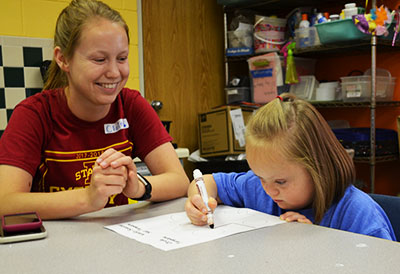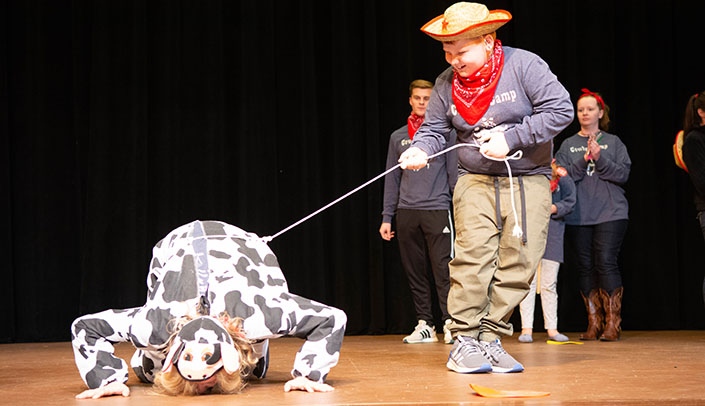“It’s never the finished product. It’s the process.”
That’s how Carolyn Anderson, director of Why Arts, an organization that provides Omaha’s underserved populations with access to inclusive quality arts programming, views artistic creation — it’s a journey. On Aug. 7, the latest performance of the Camp Munroe Theater Co. — a collaboration between the Munroe-Meyer Institute Department of Recreational Therapy and Why Arts — will be held. Called “Theater 101,” the show will be a play about a play — artwork about making art.
Participation in theater, painting and other creative arts is an important facet of the MMI Department of Recreation Therapy, and not merely to provide fun, although it does that.
A 2011 study in Hong Kong found that after completion of 12 art facilitation sessions, adult participants with developmental disabilities “showed enhanced social relationship and language comprehension based on parent and staff ratings, as compared to control participants.”
In addition, the American Art Therapy Association points to art as a way to “improve cognitive and sensorimotor functions, foster self-esteem and self-awareness, cultivate emotional resilience, promote insight, enhance social skills, reduce and resolve conflicts and distress, and advance societal and ecological change.”
And The Kennedy Center’s VSA: The International Organization on Arts and Disability, was founded more than 35 years ago to “provide arts and education opportunities for people with disabilities and increase access to the arts for all.”
 |
A child works on an art project at Camp Munroe while recreational therapy staff member Anna Reelfs looks on. |
MMI Director Karoly Mirnic, M.D., Ph.D., spoke about the increased access the theater program provides.
“The theater program allows participation by individuals who in the regular school system probably would not get into the performances at all,” he said. “It builds social skills and develops the brain, and gives confidence to individuals as well.”
But he also stressed the benefits of all types of creative art.
“Art is an important piece of brain development,” he said. “There have been quite a few studies that show that it expands the brain, that it builds new connections. Art is what we are as human beings from our earliest days; it’s part of our existence. We appreciate beauty, but we also enjoy participating in beauty, creating beauty. It’s part of our social existence.”
The bottom line, Anderson said, is that by creating art, “a person has a sense of accomplishment; they’re rewarded, they’re praised, they’re celebrated. They’re not compared to someone sitting next to them.
“Anyone can engage in the arts — everyone has the ability and should have the opportunity to be creative,” she added.
For Erin Bentzinger, now in her second year as director of the Camp Munroe Theater Co. — hosted once again this summer by the Scottish Rite — the performance art camp gives participants more options for creativity.
“I love that they are able to use their imagination and really share that,” she said.
Bentzinger and Nicole Giron, associate director of recreational therapy, also point to a rise in self-esteem as an important return for people with developmental disabilities who become involved in creative or performing art.
“There have been quite a few parents who have shared that their child or adult child may be more reserved and hesitant about doing this program,” Bentzinger said. “But after being involved in it, they have this new self-confidence.”
“It’s an opportunity for free-form expression,” Giron said. “There’s no wrong. There’s nothing that anybody needs to be corrected upon. Art is an incredible opportunity for full, whole-person expression, and it really comes from that person’s perspective.”
Artwork lets people work together with friends while expressing their own creativity, Bentzinger said.
“Once they have been up on stage, or shown their artwork in front of people, and had such positive feedback, they feel more confident in wanting to do that again,” she said. “Also, when working collaboratively, as at theater camp, it’s a new level of friendship-making. It’s not just playing a game — you’re creating something together with teamwork.”
And the arts are for everyone, Anderson said.
“The arts are so broad — there is no individual I would look at and think, ‘You can’t do the arts.'”
Dr. Mirnics pointed out that art is considered important by UNMC and Nebraska Medicine, with the Healing Arts Program, Chihuly Sanctuary and other artwork displayed in the Fred & Pamela Buffett Cancer Center and throughout campus.
“When we think of therapy, it doesn’t have only to be a medication or intervention,” he said. “It’s spirituality and art, as well – altogether, it’s overall well-being. And an important piece of that is to find beauty and participate in the creation of beauty.”

We have been to two shows down at Scottish Rite. The Greatest Show and Cowboy Camp, enjoyed both of them very much. The overall production from costumes and stage design to the young actors out there strutting their stuff it was so much fun.
Kudos to the Camp Munroe Theater Company on this initiative. I have no doubt it will have a profound impact on the children.